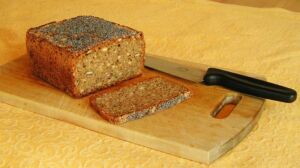Business & Education
Life without it would pull the rug out from under the entire nation
This article is more than 9 years old.
Rugbrød, the staple of the nation’s diet for centuries, is an integral ingredient of its collective consciousness. Today, it is equally at home in simple rustic food and New Nordic Cuisine

Denmark’s corn (photo: Mogens Engelund)
You don’t need to know much about this country to know there are three things a Dane will invariably miss while abroad for a long period: leverpostej (liver paté), saltlakrids (strong salt liquorice) and rugbrød (rye bread).
The Danes believe that rugbrød is one of Scandinavia’s gifts to humanity. They champion it as being healthy, hearty, moist and just lovely, and possibly the best way ever to fully appreciate rye as a crop.
Rugbrød is to Denmark what pumpernickel is to Germany. It has a somewhat milder taste compared to its German counterpart, and many foreigners who have tasted the two actually prefer rugbrød.
But still, many foreigners are a little baffled by the Danes’ love of rugbrød and tend to pigeon-hole it away with their other ‘special’ food habits. After all, it is loved so much here that they eat it for breakfast, lunch and dinner.
Just last week, it was revealed that liver pate on rugbrød is the most preferred weekday dinner, with most Danes eating it at least twice a month.
READ MORE: Rye bread with liver pate the most common dinner in Denmark
This country’s corn
Rugbrød, or at least some kind of bread made from rye flour and sourdough, has been the single most important source of nutrition throughout Danish history.
We do know that it was widely consumed throughout the Middle Ages, including in the late Iron Age and the Viking Age. Until the late 19th century, rye was the country’s corn. It is a hardy crop perfect for the Danish climate.
Wheat, in contrast, suffers in cold weather, so wheat bread could only be made using imported wheat and was costly. So until recently, like every expensive food, it has been the preserve of the upper and middle classes.
Best served hunky surely?
Until the 18th century, the typical peasant started his meal with a portion of spoon food, for example porridge or mush, and then followed it with rugbrød with some kind of topping – something like sild (herring) or flæsk (salted pork). The rugbrød was normally served without butter, but if money allowed it, it could be eaten with onion driping.
At that time the bread was probably very rough; baked with unsifted flour, it would be lumpy, sour and quite often musty. Rugbrød was therefore more commonly eaten in big hunks, not slices, to complement a meal. Older generations today fondly recall growing up eating rugbrød and savouring the big hunks and how they would make the crusts more bearable by adding lard and salt.
The best thing was sliced bread
It was not until the industrialism of the country in the late 19th century, which brought with it sliced bread, that the Danes started eating rugbrød as an open-faced sandwich (smørrebrød). Slices of rugbrød were spread with butter, margarine or lard and topped with various forms of cold meats, and smørrebrød quickly became a national food mostly eaten at lunchtime and on special occasions.
It heralded a heyday for rugbrød, during which time the average Dane ate three slices a day, but also saw a decline in the numbers of people baking their own bread as they increasingly started buying it from the baker. It wasn’t until the 1960s that baking rugbrød became common.
While it remains popular, consumption has halved over the last 20 years as sandwiches, pizza and other fast food have gained in popularity along with wheat bread − particularly franskbrød and toast bread.
Do as your parents say!
The decline is hardly drastic, though. Most Danes have grown up eating the rugbrød, and it is such an integrated part of their culture that many parents still insist their children eat it and fret if they don’t. It is mostly unthinkable among parents that any child can grow up to be normal without eating rugbrød. Or some teachers, as a controversy last year proved. In that instance a Danish teacher scolded minority pre-schoolers for eating the ‘wrong’ kind of bread.
Although the rest of the world has grown up just fine without this super food, rugbrød is both nutritional and healthy. Whole-grain rugbrød is high in dietary fibres − something most people dont get enough of. Grains with a high content of fibres reduce the risk of coronay heart disease and provide the body with a stable blood sugar level.
On top of that, rugbrød makes you feel full for much longer than white bread and is packed with vitamins and minerals. Finally, it is low in fat. So no more excuses for not tucking into this little slice of Danish food history.
Poor man’s plate inspires rich man’s palate
If anything, rugbrød has a bright future. While the average Dane eats less of it than he used to, the upper and middle classes, who since 1850 have shunned it in favour of wheat bread, are returning to it in droves as rugbrød fast becomes a trendy and exciting ingredient used in New Nordic Cuisine. Two of its biggest advocates are gastronomic entrepreneur Claus Meyer, a co-founder of the restaurant Noma, and René Redzepi, Noma’s head chef.
Meyer uses rye bread in tapas, while Redzepi serves øllebrød (traditional Danish porridge made from dark rugbrød) with cloud berries for dessert.
So from being a poor man’s food, rugbrød has emerged as a star of New Nordic Cuisine.










































